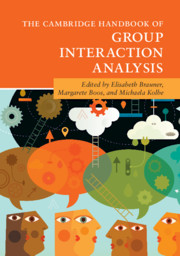
-
Select format
-
- Publisher:
- Cambridge University Press
- Publication date:
- July 2018
- August 2018
- ISBN:
- 9781316286302
- 9781107113336
- 9781107533875
- Dimensions:
- (247 x 174 mm)
- Weight & Pages:
- 1.51kg, 694 Pages
- Dimensions:
- (247 x 174 mm)
- Weight & Pages:
- 1.38kg, 694 Pages
You may already have access via personal or institutional login
Book description
This Handbook provides a compendium of research methods that are essential for studying interaction and communication across the behavioral sciences. Focusing on coding of verbal and nonverbal behavior and interaction, the Handbook is organized into five parts. Part I provides an introduction and historic overview of the field. Part II presents areas in which interaction analysis is used, such as relationship research, group research, and nonverbal research. Part III focuses on development, validation, and concrete application of interaction coding schemes. Part IV presents relevant data analysis methods and statistics. Part V contains systematic descriptions of established and novel coding schemes, which allows quick comparison across instruments. Researchers can apply this methodology to their own interaction data and learn how to evaluate and select coding schemes and conduct interaction analysis. This is an essential reference for all who study communication in teams and groups.
Reviews
‘The Cambridge Handbook of Group Interaction Analysis is an essential compendium that thoroughly covers this increasingly important team dynamics research methodology. Whether you are a novice or a seasoned expert, there are nuggets of wisdom in this collection written by a broad collection of experts. If you study team process dynamics, you need this book on your shelf.'
Steve W. J. Kozlowski - Michigan State University
'This superb handbook offers a compelling case for the benefits of interaction analysis. Stellar contributors from numerous disciplines clearly and comprehensively explicate the methods and analytic techniques of interaction analysis, review established coding schemes, and discuss interpenetration with theory. A 'must have' resource for established scholars in the area and for newcomers.'
David R. Seibold - University of California, Santa Barbara
'Brauner, Boos, and Kolbe have assembled a multidisciplinary group of experts, setting the stage for creation of a truly interdisciplinary scholarship of interaction analysis. They’ve produced a volume rich in methods and theory, yet steeped in the deep history of interaction analysis. Building from a strong evidentiary base, and accessible to a wide variety of stakeholders, this volume will serve as an indispensable guide for years to come and help accelerate our understanding of interactions in their many forms and how they contribute to social, cognitive, and emotional outcomes.'
Stephen M. Fiore - University of Central Florida, Past-president of the Interdisciplinary Network for Group Research (INGRoup)
Contents
Metrics
Altmetric attention score
Full text views
Full text views help Loading metrics...
Loading metrics...
* Views captured on Cambridge Core between #date#. This data will be updated every 24 hours.
Usage data cannot currently be displayed.
Accessibility standard: Unknown
Why this information is here
This section outlines the accessibility features of this content - including support for screen readers, full keyboard navigation and high-contrast display options. This may not be relevant for you.
Accessibility Information
Accessibility compliance for the PDF of this book is currently unknown and may be updated in the future.


